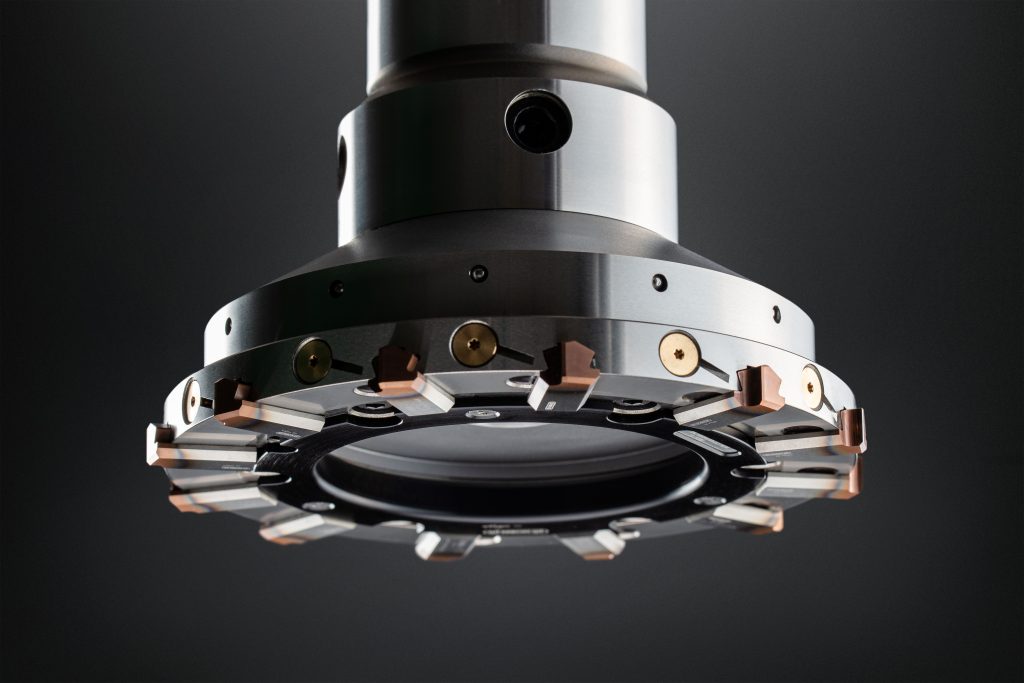Automotive industry job shops can achieve a significant time saving in a reaming process by switching to the DR small system, according to Horn GmbH. PHOTO courtesy HORN/Sauermann
By Paul Horn GmbH
Tight bore tolerances, high surface quality and almost perfect cylindricity. Boring with reaming tools is often the last machining step in the production of precise components. In addition to the features mentioned, other properties play an important role in the production of close tolerance bores. Reaming tools are usually used for this purpose. In addition to the well-known HSS reamers, special high-performance reaming systems are increasingly proving their worth in modern production.
With the DR reaming system, Paul Horn GmbH offers its own product portfolio for the economical finishing of bores.
As with other tool systems, high-performance reaming systems are also subject to demanding requirements. In addition to high process reliability, long tool life and low tool costs, modern reaming tools must fulfil further criteria. These include, among other things, the modularity of the tools. While machining with an HSS reamer is partially limited in this respect, modern reaming systems can be improved by replaceable heads with carbide inserts, modular tool lengths and various adjustment options. These include, for example, µ-accurate adjustment of concentricity and runout. Precise concentricity of the reaming inserts is the path to success. In practice, this should be within 5 µm.
Chip control
In addition to the precise grinding of the carbide insert, the appropriate tool geometry for the machining operation also plays an important role in economical reaming. Therefore, two insert orientations or side rake angles are used for reliable chip removal. Straight-insert reaming cutters are suitable for machining blind holes. Chip flow is in the opposite direction to the machining direction. Left-hand helical inserts are designed for reaming through holes only. In this case, the direction of chip flow and machining is the same.
Controlling chip breaking is an important aspect of successful boring. In deep bores, with low coolant pressure or dry machining, helical or ribbon swarf can occur. As with drilling with twist drills, the chips can be broken by briefly lifting the reamer. It is important to program as few interruptions as possible, but as many as necessary, as retractions can reduce the service life of the cutting edges. The lifting of the tool is hardly noticeable in the appearance of the machined surface.

System DR small in use
For reaming bores, a company in the vehicle manufacturing industry relies on the DR small reaming system from Horn. Before the changeover, the bores were milled or drilled and then reamed with an HSS reamer.
A spokesperson for the user noted: “The performance, machining cycle time and precision no longer satisfied us. New developments in our products with even finer mechanical and electrical components made it necessary to rethink the reaming process. The internal coolant supply was an important issue in this application. We machine many aluminium components. When reaming deep holes in aluminium, efficient cooling makes the difference between success and failure.”
The holes are reamed at a cutting feed rate of vf = 6 m/min. The machining time has been reduced by two thirds. The performance of the system has impressed the user: “We have saved a lot of time by switching to the new system. Furthermore, the tool performance as well as the quality of the reamed bores are both much better.”
Reaming large diameters
With the newly developed DR-Large reaming system, Horn has extended its expertise in boring. The tool offers easy handling and high precision thanks to the proven technology of the DR tool family. The large number of cutting edges enables high cutting values and consequent time and cost savings in machining. The user achieves great flexibility thanks to the modular design and the solid carbide inserts of the tool system. There is no need for tool adjustment when changing the cutter head. The versatile and powerful interchangeable reamer system covers bore diameters from 140 mm to 200.2 mm. Horn offers servicing for simple and fast reconditioning of worn heads.
Basically, reaming is a very economical machining process. Compared to turning or milling bores to tight tolerances, reaming is many times faster and can significantly reduce unit costs. Horn has developed a high level of know-how for economical boring and has a powerful tool system in its range with the modular, high-performance DR reaming system. It covers bore diameters from 7.6 mm to 200.2 mm. All variants are equipped with internal coolant supply directly to each cutting edge. The insert interface offers high changeover accuracy to within a few µm and enables quick and uncomplicated insert exchange.
READ NEXT:
- TECH TIPS: The advantages of using innovative tools for 90 degree milling – Shop Metalworking Technology (shopmetaltech.com)
- TECH TIPS: The smart factory of tomorrow will demand a higher level of toolholder performance – Shop Metalworking Technology (shopmetaltech.com)
- TECH TIPS: A closer look at the advantages of using Iscar’s NeoLogIQ tools and inserts – Shop Metalworking Technology (shopmetaltech.com)
- TECH TIPS: Understanding the benefits of e-catalogs for accessing cutting tool data – Shop Metalworking Technology (shopmetaltech.com)
